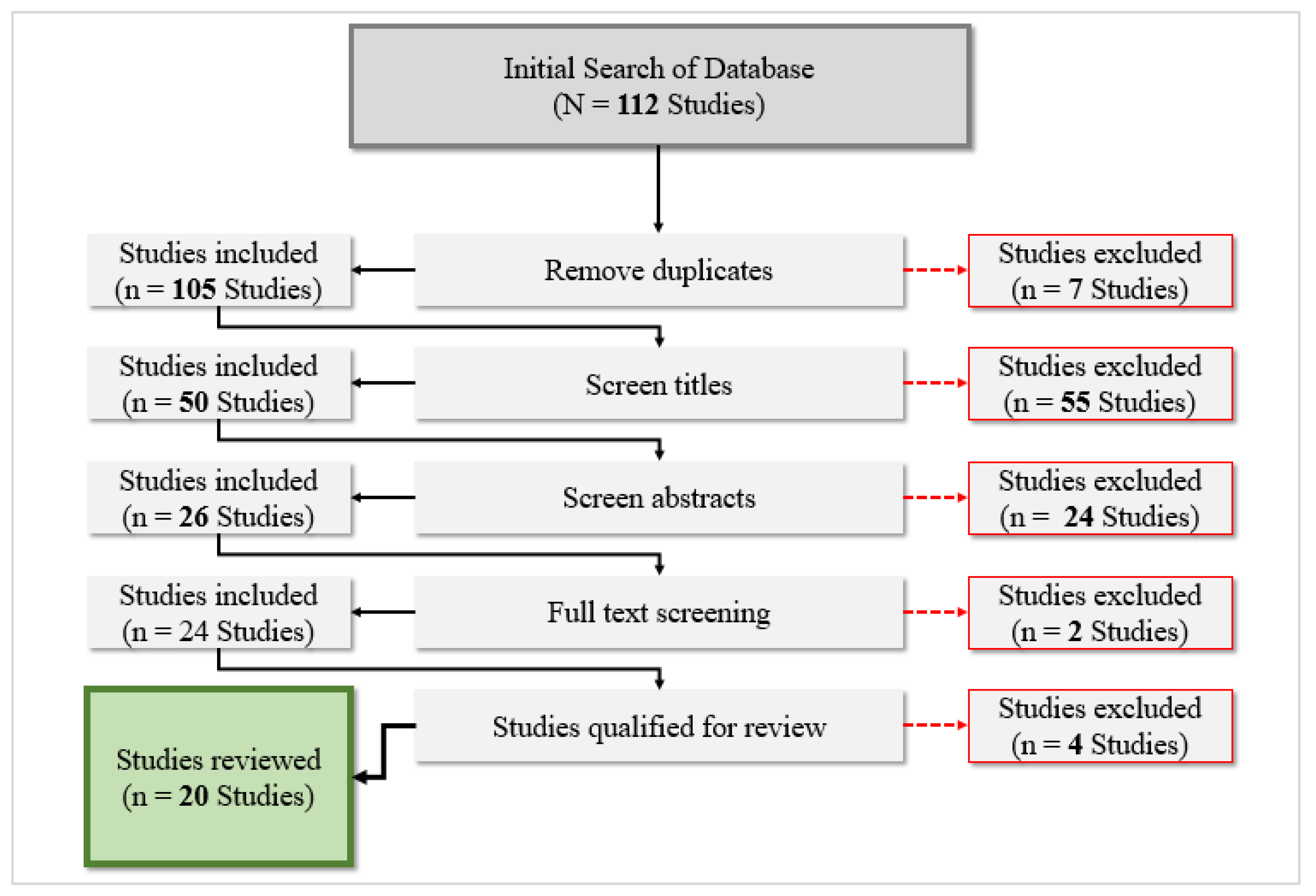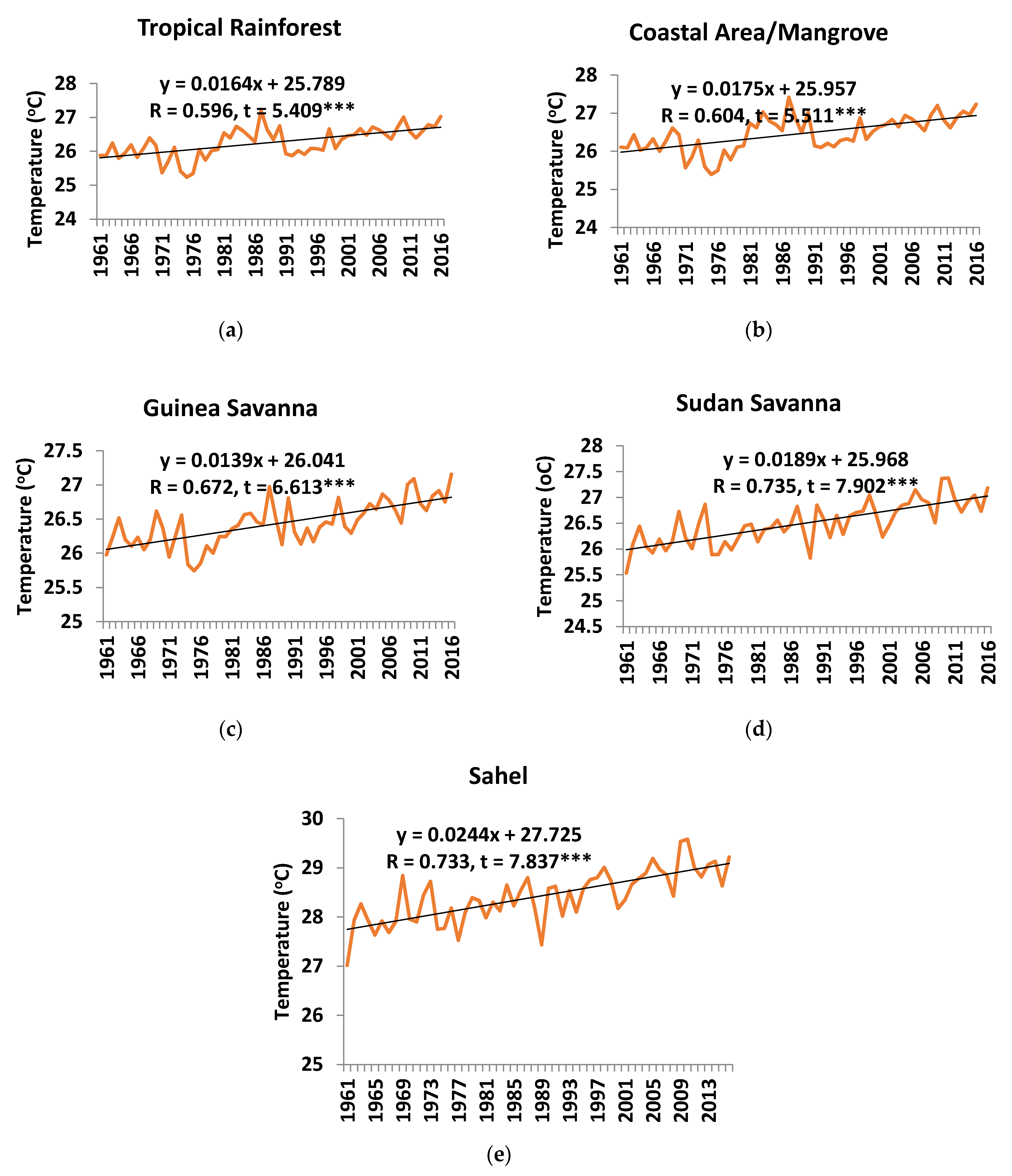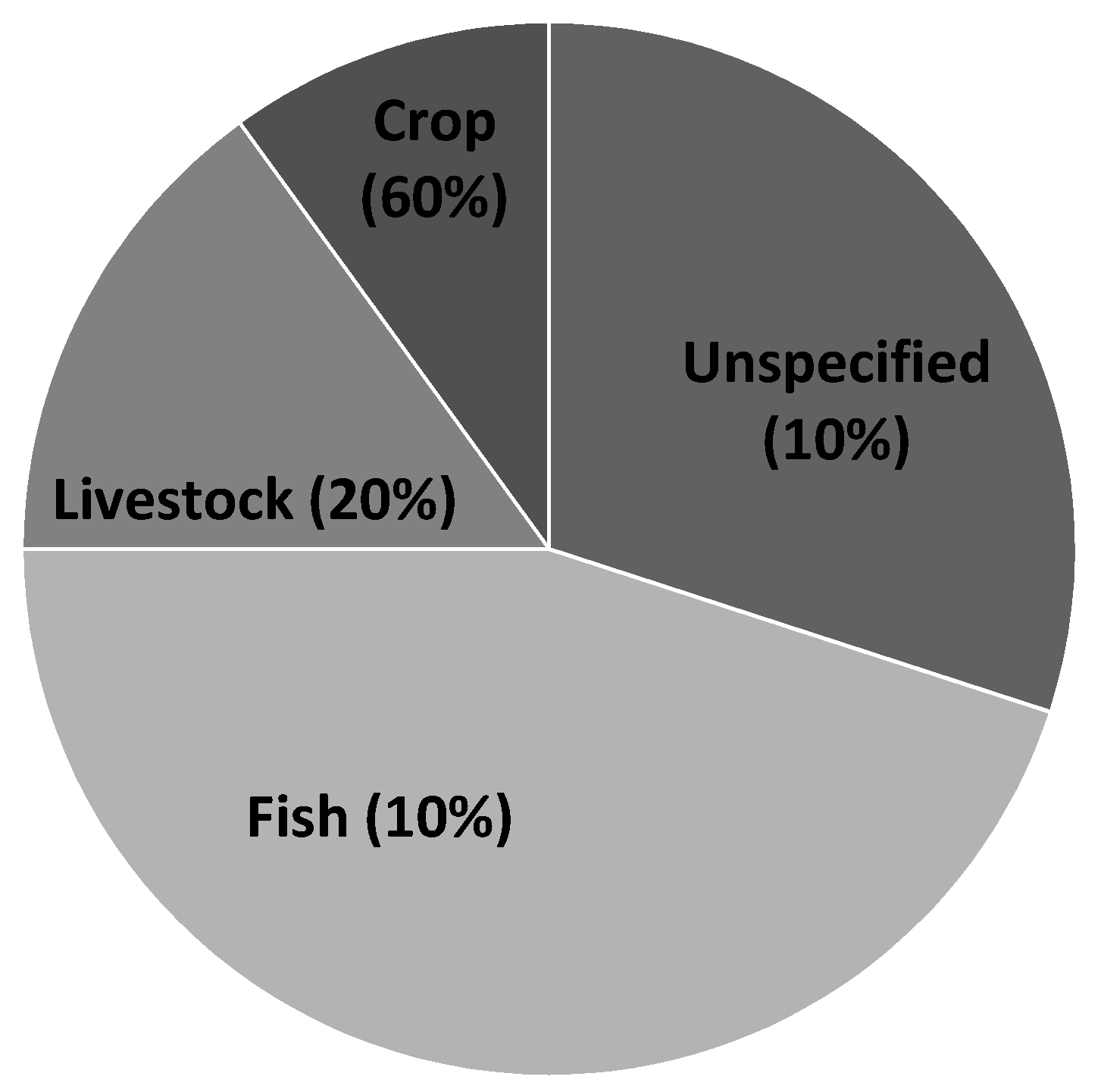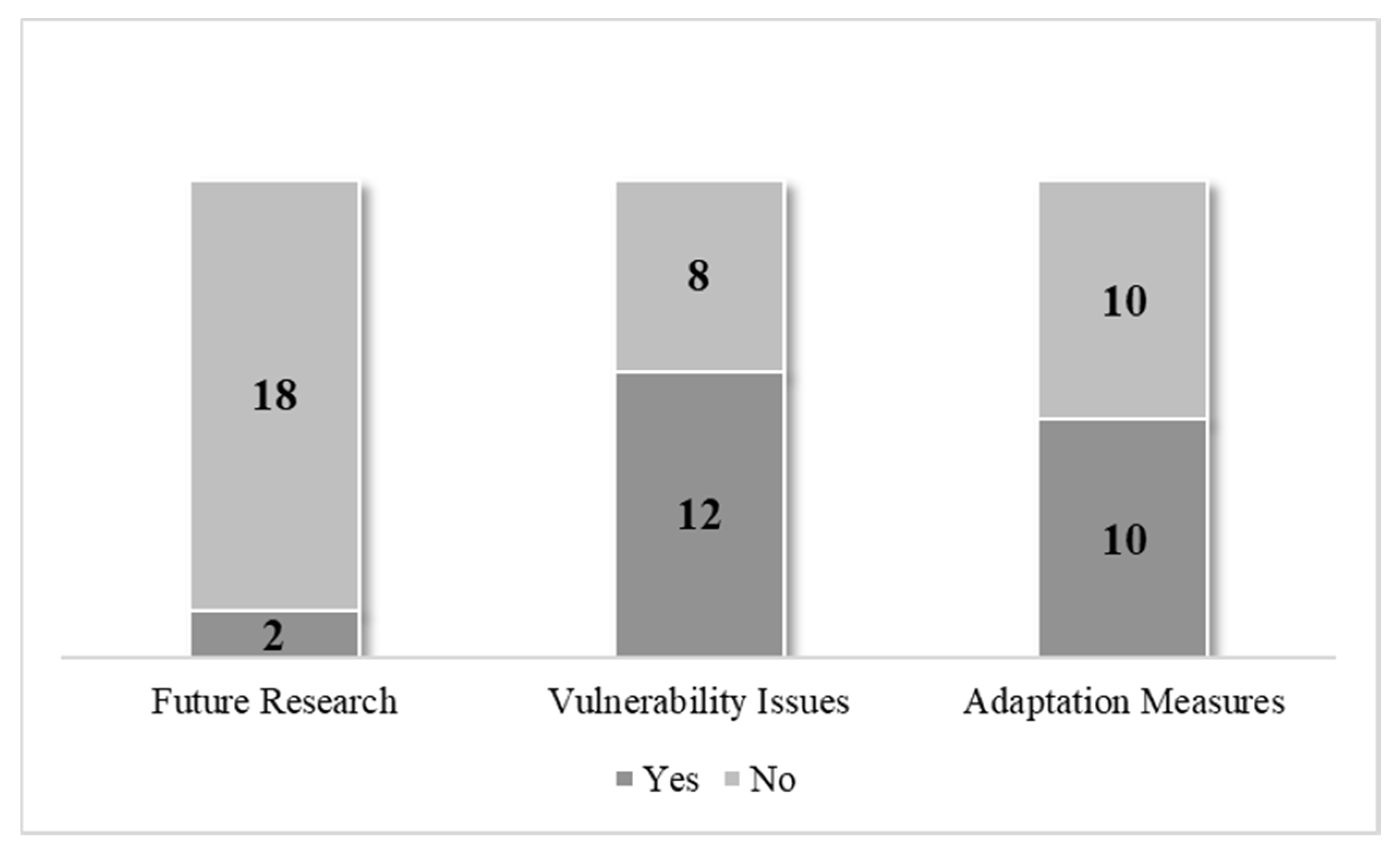Progress in Climate–Agricultural Vulnerability Assessment in Nigeria
Abstract
1. Introduction
- What is the linear variation of climate variables in Nigeria?
- What is the current state of climate impact and vulnerability assessments in Nigerian agricultural sector?
- What are the theoretical foundations, operationalization approaches, and frameworks of vulnerability assessments in Nigeria?
- Which methods are currently used in vulnerability assessments?
- Which lessons are learnt from the vulnerability studies?
2. Vulnerability
2.1. Components of Climate Change Vulnerability
2.2. Conceptual Approaches Used in Vulnerability Studies
3. Methods
3.1. Linear Variations in Climate Variables in Nigeria’s Agro-Ecological Zones
3.2. Systematic Literature Review
4. Results and Discussion
4.1. Linear Variation in Climate Variables in Nigeria’s Agro-Ecological Zones
4.1.1. Variation of Annual Temperature
4.1.2. Variation of Annual Precipitation
4.1.3. State of Climate Change Vulnerability Assessment in Nigerian Agriculture
4.1.4. Theoretical Foundations, Operationalization Approaches, and Frameworks of Vulnerability Assessments in Nigeria
4.1.5. Methods Currently used in Vulnerability Assessments
4.1.6. Lessons from the Vulnerability Studies
- Identification of Vulnerability according to various agricultural sub-sectors, agro-ecological zones, and geographical locations:The reviewed vulnerability assessment studies reported mainly on the determinants and vulnerability of agricultural sub-sectors, people, and places, as well as methodological contributions and decisions in the study areas.
- Facilitation of vulnerability and adaptation decision making:The concluding sections of the reviewed assessments provided links to their findings on vulnerability and adaptation foci. This allows identification of the possible outcomes of improving adaptation practices, which is informed by the assessments carried out. The identified beneficiaries of these assessments are policy and decision makers and all relevant stakeholders.
5. Conclusions
Author Contributions
Funding
Conflicts of Interest
Appendix A
| Serial/Number | Author(s) | Primary Data | Secondary Data | Data Collection Tool | Vulnerability Proxy | Main Analytical Approach |
|---|---|---|---|---|---|---|
| 1 | Abaje et al. [38] | ✓ | Household Survey | Composite Vulnerability Index | Statistical method (principal component analysis, index computation, and fixed effects regression) | |
| 2 | Adeoti et al. [39] | ✓ | ✓ | Questionnaire, NIMET | Composite Vulnerability Index | Statistical method (descriptive, index computation, and multinomial logit regression) |
| 3 | Adewuyi et al. [40] | ✓ | ✓ | NIMET Database, Questionnaire | Composite Vulnerability Index | Statistical method (descriptive, trend, principal component analysis, index computation, and linear regression) |
| 4 | Ajibola [18] | ✓ | ✓ | Fadama-II Database, NIMET | Log of Consumption Loss Per Agricultural Household | Statistical method of vulnerability as exposure to uninsured risk (instrumental variable, logit regressions) |
| 5 | Atedhor [36] | ✓ | ✓ | Questionnaire, NIMET | Unspecified | Statistical method (descriptive statistics, trend analysis. and ordinary least squares (OLS) regression) |
| 6 | Awolala and Ajibefun [41] | ✓ | Questionnaire | Composite Vulnerability Index | Statistical method (descriptive and index computation) | |
| 7 | Awoyemi and Olajide [42] | ✓ | Household Survey | Composite Vulnerability Index | Statistical method (principal component analysis, index computation, and fixed effects regression) | |
| 8 | Ayanlade and Ojebisi [43] | ✓ | ✓ | Questionnaire | Drought and Fodder Sufficiency | Statistical method (descriptive statistics, trend analysis) |
| 9 | Aye and Ater [44] | ✓ | NBS, World Weather Records, Global Historical Climatology Network (GHCN) v.3 (2011) Database | Crop Yield | Statistical (multiple linear regression) | |
| 10 | Building Nigeria’s Response to Climate Change (BNRCC) [6] | ✓ | ✓ | Focus Group, Interviews, Questionnaire | Various | Indicator method, statistical method |
| 11 | Cervigni et al. [45] | ✓ | GIS, Expert Review of National Adaptation Strategy and Plan of Action on Climate Change for Nigeria (NASPA-CCN) | Yield (t/ha) (Crop); Temperature Humidity Index (Livestock); Gross Primary Productivity (Livestock) | Spatial mapping (remote sensing and GIS techniques, re-scaling normalization technique) | |
| 12 | Chikezie et al. [46] | ✓ | Questionnaire | Composite Vulnerability Index | Indicator method (principal component analysis), statistical method (ordinary least squares regression) | |
| 13 | Chukwuemeka et al. [47] | ✓ | Questionnaire, Focus Group Discussions | Composite Vulnerability Index | Indicator method (index computation) | |
| 14 | Eze et al. [48] | ✓ | Questionnaire | Composite Vulnerability Index | Indicator method (principal component analysis, correspondence analysis) | |
| 15 | Madu [37] | ✓ | Nigerian Annual Abstract of Statistics 2009 Database; General Household Survey 2006 Database; Core Welfare indicator Questionnaire Survey (CWIQ) 2006 Database | Composite Vulnerability Index | Indicator/statistical method (descriptive analysis, principal component analysis, cluster analysis) | |
| 16 | Madu [49] | ✓ | Nigerian Annual Abstract of Statistics 2009 and General Household Survey 2006 | Composite Vulnerability Index | Indicator/statistical method (descriptive analysis, principal component analysis, index computation, Pearson’s product correlation analysis) | |
| 17 | Manu et al. [50] | ✓ | ✓ | Questionnaire, NIMET Database | Composite Vulnerability Index | Indicator/statistical method (descriptive analysis, principal component analysis) |
| 18 | Medugu and Majid [51] | ✓ | Questionnaire, Interviews, Focus Group Discussions | Composite Vulnerability Index | Indicator method (descriptive, weighting, and averaging indicators) | |
| 19 | Ojo [52] | ✓ | GIS, NIMET; Federal Ministry of Agriculture | Crop Yield | Spatial mapping (GIS techniques and re-scaling normalization technique) | |
| 20 | Umar et al. [35] | ✓ | NIMET | Crop Yield | Statistical method (descriptive statistics, trend analysis) |
References
- Williams, P.A.; Crespo, O.; Abu, M.; Simpson, N.P. A systematic review of how vulnerability of smallholder agricultural systems to changing climate is assessed in Africa. Environ. Res. Lett. 2018, 13, 1–19. [Google Scholar] [CrossRef]
- Morgan, C.L. Vulnerability Assessments A Review of Approaches; IUCN: Gland, Switzerland, 2011. [Google Scholar]
- Pachauri, R.K.; Allen, M.R.; Barros, V.R.; Broome, J.; Cramer, W.; Christ, R.; Church, J.A.; Clarke, L.; Dahe, Q.; Dasgupta, P.; et al. Climate Change 2014: Synthesis Report. Contribution of Working Groups I, II and III to the Fifth Assessment Report of the Intergovernmental Panel on Climate Change; Core-Writing-Team, Pachauri, R.K., Meyer, L., Eds.; IPCC: Geneva, Switzerland, 2014; ISBN 9789291691432. [Google Scholar]
- IPOC. Climate Change 2013 The Physical Science Basis Working Group I Contribution to the Fifth Assessment Report of the Intergovernmental Panel on Climate Change; Stocker, T.F., Qin, D., Plattner, G.-K., Tignor, M.M.B., Allen, S.K., Boschung, J., Nauels, A., Xia, Y., Bex, V., Midgley, P.M., Eds.; Cambridge University Press: New York, NY, USA, 2013; ISBN 9781107661820. [Google Scholar]
- Panthi, J.; Aryal, S.; Dahal, P.; Bhandari, P.; Krakauer, N.Y.; Pandey, V. Livelihood vulnerability approach to assessing climate change impacts on mixed agro-livestock smallholders around the Gandaki River Basin in Nepal. Reg. Environ. Chang. 2016, 16, 1121–1132. [Google Scholar] [CrossRef]
- BNRCC. Reports of Pilot Projects in Community-based Adaptation-Climate Change in Nigeria; NEST, Woodley, E., Eds.; Building Nigeria’s Response to Climate Change (BNRCC) and Nigerian Environmental Study/Action Team (NEST): Ibadan, Nigeria, 2011. [Google Scholar]
- OECD/FAO. OECD-FAO Agricultural Outlook 2016–2025: Special Focus on Sub-Saharan Africa; OECD Publishing: Paris, France, 2016; ISBN 9789264253223. [Google Scholar]
- Hitayezu, P.; Zegeye, E.W.; Ortmann, G.F. Some Aspects of Agricultural Vulnerability to Climate Change in the KwaZulu-Natal Midlands, South Africa: A Systematic Review. J. Hum. Ecol. 2014, 48, 347–356. [Google Scholar] [CrossRef]
- Füssel, H.M. Adaptation planning for climate change: Concepts, assessment approaches, and key lessons. Sustain. Sci. 2007, 2, 265–275. [Google Scholar] [CrossRef]
- Dumenu, W.K.; Obeng, E.A. Climate change and rural communities in Ghana: Social vulnerability, impacts, adaptations and policy implications. Environ. Sci. Policy 2016, 55, 208–217. [Google Scholar] [CrossRef]
- Nyamwanza, A.M.; New, M.G.; Fujisawa, M.; Johnston, P.; Hajat, A. Contributions of decadal climate information in agriculture and food systems in east and southern Africa. Clim. Chang. 2017, 143, 115–128. [Google Scholar] [CrossRef]
- Preston, B.L. Climate Change Vulnerability Assessment: From Conceptual Frameworks to Practical Heuristics; CSIRO Climate Adaptation Flagship: Clayton, Victoria, Australia, 2013; No. 16. [Google Scholar]
- Bisaro, A.; Wolf, S.; Hinkel, J. Framing climate vulnerability and adaptation at multiple levels: Addressing climate risks or institutional barriers in Lesotho? Clim. Dev. 2010, 2, 161–175. [Google Scholar] [CrossRef]
- Deressa, T.; Hassan, R.M.; Ringler, C. Measuring Ethiopian Farmers’ Vulnerability to Climate Change across Regional States; IFPRI: Washington, DC, USA, 2008. [Google Scholar]
- Hoddinott, J.; Quisumbing, A. Methods for Microeconometric Risk and Vulnerability Assessments; IFRPRI: Washington, DC, USA, 2003. [Google Scholar]
- Adger, W.N.; Kelly, P.M. Social Vulnerability to Climate Change and the Architecture of Entitlements. Glob. Chang. 1999, 4, 253–266. [Google Scholar]
- Kelly, P.M.; Adger, W.N. Theory and Practice in Assessing Vulnerability to Climate Change and Facilitating Adaptation. Clim. Chang. 2000, 47, 325–352. [Google Scholar] [CrossRef]
- Ajibola, A.O. Climate Change Effects on Household Agric-Economy and Adaptive Responses among Agricultural Households in Nigeria. In Proceedings of the Contribution Paper for Presentation at the CSAE 2014: Centre for the Study of African Economies at St. Catherines College, Oxford, UK, 23–25 March 2014. [Google Scholar]
- Mendelsohn, R.; Nordhaus, W.D.; Shaw, D. The Impact of Global Warming on Agriculture: A Ricardian Analysis. Am. Econ. Rev. 1994, 84, 753–771. [Google Scholar]
- Mendelsohn, R. The Impact of Climate Change on Agriculture in Developing Countries. J. Nat. Resour. Policy Res. 2008, 1, 5–19. [Google Scholar] [CrossRef]
- Olesen, J.E.; Bøcher, P.K.; Jensen, T. Comparison of scales of climate and soil data for aggregating simulated yields of winter wheat in Denmark. Agric. Ecosyst. Environ. 2000, 82, 213–228. [Google Scholar] [CrossRef]
- Cutter, S.L.; Mitchell, J.T.; Scott, M.S. Revealing the vulnerability of people and places: A case study of Georgetown county, South carolina. Ann. Assoc. Am. Geogr. 2000, 90, 713–737. [Google Scholar] [CrossRef]
- Füssel, H.M.; Klein, R.J.T. Climate change vulnerability assessments: An evolution of conceptual thinking. Clim. Chang. 2006, 75, 301–329. [Google Scholar] [CrossRef]
- Harris, I.; Jones, P.D.; Osborn, T.J.; Lister, D.H. Updated high-resolution grids of monthly climatic observations – the CRU TS TS v4.03 Dataset. Int. J. Climatol. 2014, 34, 623–642. [Google Scholar] [CrossRef]
- Mcmahon, T.A.; Peel, M.C.; Karoly, D.J. Assessment of precipitation and temperature data from CMIP3 global climate models for hydrologic simulation. Hydrol. Earth Syst. Sci. 2015, 19, 361–377. [Google Scholar] [CrossRef]
- Dong, B.; Sutton, R. Dominant role of greenhouse-gas forcing in the recovery of Sahel rainfall. Nat. Clim. Chang. 2015, 5, 757–760. [Google Scholar] [CrossRef]
- Mahmood, R.; Jia, S.; Zhu, W. Analysis of climate variability, trends, and prediction in the most active parts of the Lake Chad basin, Africa. Sci. Rep. 2019, 9, 1–18. [Google Scholar] [CrossRef]
- Oloruntade, A.J.; Mohammad, T.A.; Aimrun, W. Rainfall Trends in the Niger-South Basin, Nigeria, 1948–2008. Sci. Technol. 2017, 25, 479–496. [Google Scholar]
- Ford, J.D.; Pearce, T. What we know, do not know, and need to know about climate change vulnerability in the western Canadian Arctic: A systematic literature review. Environ. Res. Lett. 2010, 5, 1–9. [Google Scholar] [CrossRef]
- Ford, J.D.; Berrang-ford, L.; Paterson, J. A systematic review of observed climate change adaptation in developed nations A letter. Clim. Chang. 2011, 106, 327–336. [Google Scholar] [CrossRef]
- Tánago, I.G.; Urquijo, J.; Blauhut, V.; Gonza, I.; Stefano, L. De Learning from experience: A systematic review of assessments of vulnerability to drought. Nat. Hazards 2016, 80, 951–973. [Google Scholar] [CrossRef]
- Singh, C. How do we assess vulnerability to climate change in India? A systematic review of literature. Reg. Environ. Chang. 2016, 17, 527–538. [Google Scholar] [CrossRef]
- Freduah, B.S.; Maccarthy, D.S.; Adam, M.; Ly, M.; Ruane, A.C.; Timpong-jones, E.C.; Traore, P.S.; Boote, K.J. Sensitivity of Maize Yield in Smallholder Systems to Climate Scenarios in Semi-Arid Regions of West Africa: Accounting for Variability in Farm Management Practices. Agronomy 2019, 9, 639. [Google Scholar] [CrossRef]
- Akinbile, C.O.; Ogunmola, O.O.; Abolude, A.T.; Akande, S.O. Trends and spatial analysis of temperature and rainfall patterns on rice yields in Nigeria. Atmos. Sci. Lett. 2019, 1–13. [Google Scholar] [CrossRef]
- Umar, A.T.; Mashi, S.A.; Bako, M.M. Investigation of Rainfall Characteristics in Sudano-Sahelian Region of Nigeria (1971–2006) BT—Handbook of Climate Change Resilience; Leal Filho, W., Ed.; Springer International Publishing: Cham, Switzerland, 2018; pp. 1–27. ISBN 978-3-319-71025-9. [Google Scholar]
- Atedhor, G. Agricultural Vulnerability to Climate Change in Sokoto State, Nigeria. Afr. J. Food Agric. Nutr. Dev. 2015, 15, 9855–9871. [Google Scholar]
- Madu, I.A. Spatial vulnerability assessments of rural households to climate change in Nigeria: Towards evidence-based adaptation policies 2012. In Proceedings of the Berlin Conference on the Human Dimensions of Global Environmental Change, Berlin, Germany, 5–6 October 2012; pp. 1–23. [Google Scholar]
- Abaje, I.B.; Onu, V.; Abashiya, M.; Oyatayo, K.T.; Ibrahim, A.A.; Ati, O.F.; Sawa, B.A. Climate Change Vulnerability Assessment in the Northern Part of Katsina State, Nigeria: A Quantitative Approach. Dutse J. Pure Appl. Sci. 2017, 3, 1–14. [Google Scholar]
- Adeoti, A.I.; Coster, A.S.; Akanni, T.A. Analysis of Farmers’ Vulnerability, Perception Adaptation to Climate Change in Kwara State, Nigeria. Int. J. Clim. Res. 2016, 1, 1–16. [Google Scholar]
- Adewuyi, S.A.; Folorunso, B.; Okojie, L.O.; Akerele, D. Effect of climate change on food crop production and vulnerability assessment in Oyo State. J. Econ. Int. Financ. 2015, 7, 18–24. [Google Scholar]
- Awolala, D.O.; Ajibefun, I.A. Rice Farmers’ Vulnerability to Extreme Climate: Deploying Local Adaptation Finance in Ekiti State, Nigeria. World Environ. 2015, 5, 91–100. [Google Scholar]
- Awoyemi, A.E.; Olajide, O.A. Assessment of the Degree of Households’ Vulnerability to Climate Variability in Nigeria BT—Handbook of Climate Change Resilience; Leal Filho, W., Ed.; Springer International Publishing: Cham, Switzerland, 2018; pp. 1–16. ISBN 978-3-319-71025-9. [Google Scholar]
- Ayanlade, A.; Ojebisi, S.M. Climate Variability and Change in Guinea Savanna Ecological Zone, Nigeria: Assessment of Cattle Herders’ Responses BT—Handbook of Climate Change Resilience; Leal Filho, W., Ed.; Springer International Publishing: Cham, Switzerland, 2018; pp. 1–19. ISBN 978-3-319-71025-9. [Google Scholar]
- Aye, G.C.; Ater, P.I. Impact of Climate Change on Grain Yield and Variability in Nigeria: A Stochastic Production Model Approach. Mediterr. J. Soc. Sci. 2012, 3, 142–150. [Google Scholar]
- Cervigni, R.; Valentini, R.; Santini, M. Toward Climate-Resilient Development in Nigeria; The World Bank: Washington, DC, USA, 2013; ISBN 9780821399231. [Google Scholar]
- Chikezie, C.; Ibekwe, U.C.; Ohajianya, D.O.; Orebiyi, J.S.; Ibeagwa, O.B. Vulnerability of Food Crop Farmers to Climate Change in South Eastern Nigeria. Asian J. Agric. Ext. Econ. Sociol. 2019, 30, 1–8. [Google Scholar] [CrossRef]
- Chukwuemeka, S.U.; Kingsley, O.A.; Ume, C. Climate Change Vulnerability Analysis of Smallholder Farmers in Enugu State Nigeria: Gender Sensitive Approach. J. Arid. Agric. 2018, 4, 1–6. [Google Scholar]
- Eze, J.N.; Aliyu, U.; Alhaji-Baba, A. Analysis of Farmers’ Vulnerability to Climate Change in Niger State, Nigeria. Int. Lett. Soc. Humanist. Sci. 2018, 82, 1–9. [Google Scholar] [CrossRef]
- Madu, I.A. Rurality and climate change vulnerability in Nigeria: Assessment towards evidence based even rural development policy 2016. In Proceedings of the Berlin Conference on Global Environmental Change, Berlin, Germany, 23–24 May 2016. [Google Scholar]
- Manu, H.I.; Muhammad, N.; Maina-Bukar, Y.; Abdullahi, Y.R. Climatic Variability and Livelihood Vulnerability in Kaduna State, Nigeria. Int. J. Clim. Stud. 2017, 1, 36–53. [Google Scholar]
- Medugu, I.N.; Majid, M.R. Assessing the vulnerability of farmers, fishermen and herdsmen to climate change: A case study from Nigeria. Int. J. Glob. Warm. 2014, 6, 1–14. [Google Scholar] [CrossRef]
- Ojo, O.I.; Olaniyan, A.O.; Gbadegesin, A.S.; Ilunga, M.F. Assessment of Climatic Variability Effect on Millet Production and Yield BT—Handbook of Climate Change Resilience; Leal Filho, W., Ed.; Springer International Publishing: Cham, Switzerland, 2018; pp. 1–21. ISBN 978-3-319-71025-9. [Google Scholar]






| Search Stages | Inclusion Criteria | Exclusion Criteria |
|---|---|---|
| Initial search | Studies published in English | Studies published in other languages |
| Climate-change-related vulnerability in the agricultural sector | Climate-change-related vulnerability in the non-agricultural sector | |
| Studies focused on Nigeria | Other countries | |
| Distinct/single studies | Non-distinct/duplicates | |
| Title and abstract screening | Strictly focused on agricultural systems (crop, livestock, poultry, and fish production) | Non-agricultural systems (crop, livestock, poultry. and fish production) |
| Focus on vulnerability associated with climate risks | Focus on vulnerability associated with non-climate risks | |
| Final step for review | Non-systematic review studies | Systematic literature review or discourse analysis |
| Livelihoods for rural farmers households | Livelihoods for non-farm households | |
| Vulnerability studies focused on agricultural systems/productivity | Vulnerability studies focused on non-agricultural systems/productivity |
| Agroecological Zone | Rainfall (mm) | Temperature (°C) |
|---|---|---|
| Coastal Area/Mangrove | 2945.71 ± 408.29 (13.86%) | 26.46 ± 0.46 (1.74%) |
| Rainforest | 2164.96 ± 360.97 (16.67%) | 26.26 ± 0.43 (1.64%) |
| Guinea Savanna | 1204.14 ± 211.99 (17.61%) | 26.44 ± 0.33 (1.25%) |
| Sudan Savanna | 571.31 ± 144.94 (25.37%) | 26.51 ± 0.41 (1.55%) |
| Sahel | 440.46 ± 110.24 (25.03%) | 28.42 ± 0.53 (1.86%) |
| Author (Year) | Agro-Eco Zone | Vulnerability Measure | Theory | Subjective | Socioeconomic | Biophysical | Integrated Assessment |
|---|---|---|---|---|---|---|---|
| Abaje et al. [38] | GS | CVI | ✓ | ✓ | |||
| Adeoti et al. [39] | GS | CVI | ✓ | ✓ | |||
| Adewuyi et al. [40] | TR, GS | CVI | ✓ | ✓ | ✓ | ✓ | |
| Ajibola [18] | All | LnCLAH | ✓ | ✓ | ✓ | ✓ | |
| Atedhor [36] | SdS | U | ✓ | ✓ | |||
| Awolala and Ajibefun [41] | TR, GS | CVI | ✓ | ✓ | ✓ | ||
| Awoyemi and Olajide [42] | All | CVI | ✓ | ✓ | |||
| Ayanlade and Ojebisi [43] | GS | D, FS | ✓ | ✓ | |||
| Aye and Ater [44] | All | CY | ✓ | ✓ | |||
| Building Nigeria’s Response to Climate Change (BNRCC) [6] | ShS, GS, TR, MF | V | ✓ | ✓ | ✓ | ✓ | ✓ |
| Cervigni et al. [45] | All | CY, LTHI, LGPP | ✓ | ✓ | ✓ | ||
| Chikezie et al. [46] | TR | CVI | ✓ | ✓ | |||
| Chukwuemeka et al. [47] | TR | CVI | ✓ | ✓ | |||
| Eze et al. [48] | GS | CVI | ✓ | ✓ | ✓ | ✓ | |
| Madu [37] | All | CVI | ✓ | ✓ | ✓ | ✓ | |
| Madu [49] | All | CVI | ✓ | ✓ | ✓ | ✓ | |
| Manu et al. [50] | GS, SdS | CVI | ✓ | ✓ | |||
| Medugu and Majid [51] | U | CVI | ✓ | ✓ | |||
| Ojo et al. [52] | GS | CY | ✓ | ✓ | |||
| Umar et al. [35] | SdS, ShS | CY | ✓ | ✓ |
| Agro-Ecological Focus | Frequency | Percentage |
|---|---|---|
| All | 6 | 22.22 |
| Guinea Savanna | 9 | 33.33 |
| Sudan Savanna | 3 | 11.11 |
| Sahel | 2 | 7.41 |
| Tropical Rainforest | 5 | 18.52 |
| Unspecified | 1 | 3.70 |
| Mangrove Forest | 1 | 3.70 |
© 2020 by the authors. Licensee MDPI, Basel, Switzerland. This article is an open access article distributed under the terms and conditions of the Creative Commons Attribution (CC BY) license (http://creativecommons.org/licenses/by/4.0/).
Share and Cite
Onyeneke, R.U.; Emenekwe, C.C.; Munonye, J.O.; Nwajiuba, C.A.; Uwazie, U.I.; Amadi, M.U.; Izuogu, C.U.; Njoku, C.L.; Onyeneke, L.U. Progress in Climate–Agricultural Vulnerability Assessment in Nigeria. Atmosphere 2020, 11, 190. https://doi.org/10.3390/atmos11020190
Onyeneke RU, Emenekwe CC, Munonye JO, Nwajiuba CA, Uwazie UI, Amadi MU, Izuogu CU, Njoku CL, Onyeneke LU. Progress in Climate–Agricultural Vulnerability Assessment in Nigeria. Atmosphere. 2020; 11(2):190. https://doi.org/10.3390/atmos11020190
Chicago/Turabian StyleOnyeneke, Robert Ugochukwu, Chukwuemeka Chinonso Emenekwe, Jane Onuabuchi Munonye, Chinyere Augusta Nwajiuba, Uwazie Iyke Uwazie, Mark Umunna Amadi, Chibuzo Uzoma Izuogu, Chukwudi Loveday Njoku, and Louis Uchenna Onyeneke. 2020. "Progress in Climate–Agricultural Vulnerability Assessment in Nigeria" Atmosphere 11, no. 2: 190. https://doi.org/10.3390/atmos11020190
APA StyleOnyeneke, R. U., Emenekwe, C. C., Munonye, J. O., Nwajiuba, C. A., Uwazie, U. I., Amadi, M. U., Izuogu, C. U., Njoku, C. L., & Onyeneke, L. U. (2020). Progress in Climate–Agricultural Vulnerability Assessment in Nigeria. Atmosphere, 11(2), 190. https://doi.org/10.3390/atmos11020190






